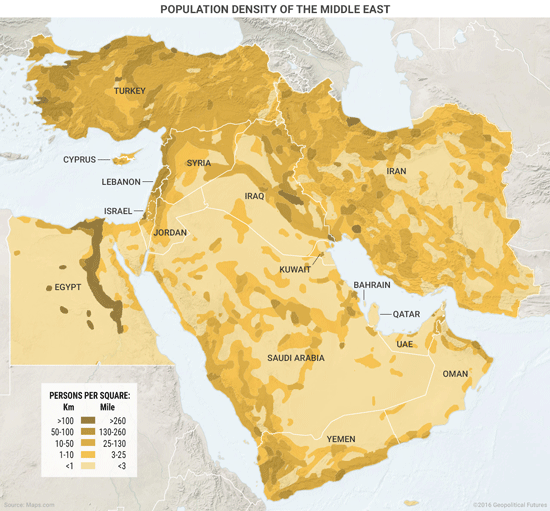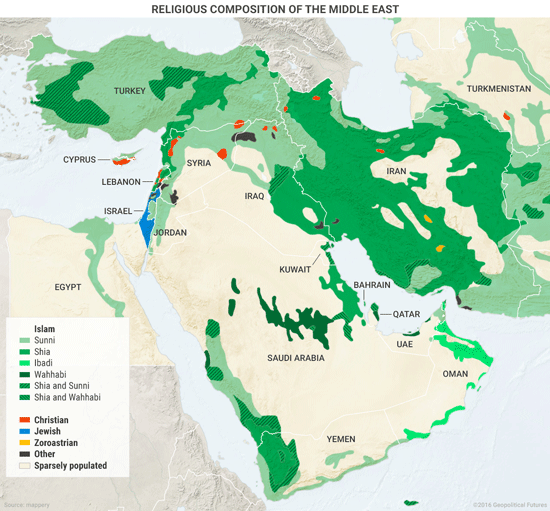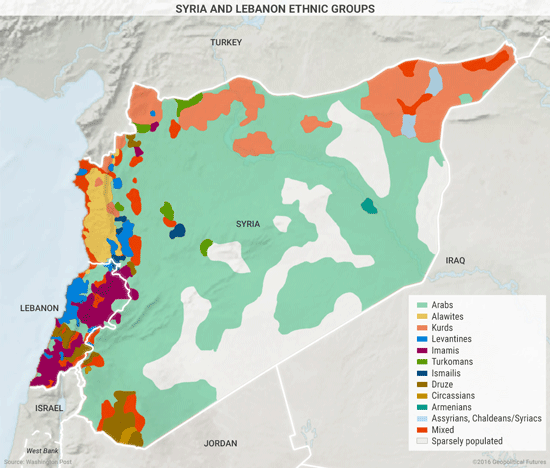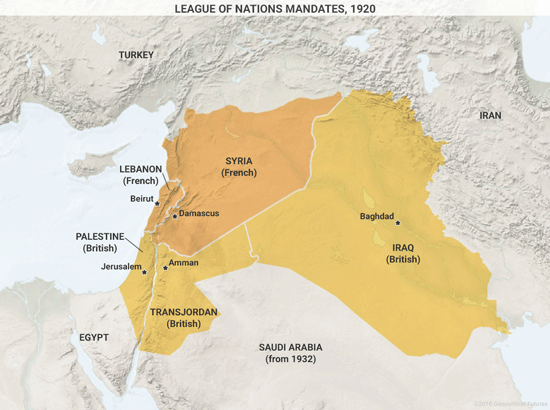Out of sheer necessity, the name “Middle East” was invented at the start of the 20th century. The need for a name was anchored in a geographic puzzle: how to distinguish the region between the Near East and the Far East. Depending on whom you ask, credit for coining the term “Middle East” goes to either the American military or the British government. Either way, the area’s new identity was determined by outsiders.
The term Near East originally referred to the Ottoman Empire, while the Far East meant East Asia. When the Ottoman Empire disintegrated, it was vital to find a new term for the area that is today Turkey. The name “middle east” was popularized in 1902 by US Naval strategist Alfred Thayer Mahan in an article he authored that ran in the National Review. It has since entered the global lexicon as a term that everyone knows yet few can quite define.
Today, the region that stretches from the eastern Mediterranean to the Iran-Afghan border, and from Turkey south (to include the entire Arabian Peninsula) is what we know as the Middle East.

In this Middle East, the Arab world stretches from Morocco to Iraq and excludes non-Arab Muslim countries like Turkey and Iran.
If we think in terms of the Muslim world, this Middle East might stretch from Morocco to Afghanistan, south into Africa, and north into Central Asia and southeastern Europe.
The Middle East is the Arab core of the Muslim world. But thinking about the Middle East as exclusively Arab doesn’t work. Doing so excludes Turkey and Iran, plus a very large Kurdish population spread across Iran, Iraq, Turkey, and Syria.
As well, viewing it as exclusively Muslim is deeply flawed. It would mean focusing on just a small part of the Muslim world. It also overlooks the Jews, Christians, Druze, Yazidis, Zoroastrians, Bahai, and other religious groups in the region.
The idea of the Middle East has become quite vague. In my view, it is tied together by this concept: The Middle East is where perhaps the world’s most complex war is raging, and Middle Eastern countries are those that are involved in this war, one way or another. The war may metastasize into neighboring regions, but this is its heart.

Typically, mountainous terrain is less populated than lowlands due to factors like ease of making a living. Not so in the Middle East… since much of the lowlands lack water and offer a rather inhospitable quality of life.
Overall, the population is concentrated in the mountains of Iran, Iraq, and Turkey. Secondary concentrations are found on the eastern Mediterranean coast and the southwestern and southeastern Arabian Peninsula.

In our view, conflicts begin with geography, as communities strive for security within their geography. Some people achieve security in remote mountain valleys. Others, like the Israelis, are always insecure, caught on the lowlands without any natural barriers.
But an understanding of these many religious factions is not enough, as religious diversity is complicated by an array of ethnic subgroups.

The Druze are neither Muslim nor Christian, but can find themselves allied with either. The Druze who live in Israel are allied with Israel.
The complexity of ethnic groups is partly due to the nature of mountainous regions, but also to the policy of the Ottomans. The Ottomans dominated this region for centuries. But unlike Muslim and Christian conquerors, they didn't pursue religious uniformity through forced conversion as long as the populace pledged their allegiance to the Ottomans.
Thus, when the Ottomans retreated after World War I, they left behind a chaotic jumble of ethnic groups tied to various religions. Each group had the strength to survive but lacked enough strength to conquer the others. The consequence is inherent instability.
The previous two maps show why all attempted conquests have failed to some degree.
The lowlands are mainly desert and relatively underpopulated, which means that aggression was limited to low-level conflicts. On the lowlands, it is relatively easy for conquerors to come and go, and transform the population to reflect their values along the way.
The mountainous northern region has highly diversified cultures and religions, and the terrain renders it difficult to conquer completely. Aggressors may control the main roads and mountain passes, but going into every valley is impossible. Mountains give the advantage to the defender, and unless a region is strategically critical, the conquerors will opt to leave them alone.
The outcome is that mountain regions around the world—like the Caucasus, Balkans, or Appalachians—tend to protect unique cultures from annihilation. And proximity to people who differ from you results in conflict. These conflicts are ancient and repeat themselves.
Moments of peace in both the mountains and the lowlands only occurred when one of the mountain nations was militarily and economically victorious and spread its influence south into what is today the Arab world. The latest and most important from our point of view was the Ottoman Empire.

The subsequent fragmentation of the empire laid the groundwork for the emergence of the modern Middle East.

The Europeans believed in the European-style nation-state as devoutly as if it were a religion. They divided the region into five states: Iraq, Syria, Palestine, Transjordan, and Lebanon.
It is important to understand how artificial these entities were. The French took the northwest portion and consolidated it into one large state, Syria. However, they had backed the Maronite Christians in a prior civil war and wanted them to have their own state. They did this by carving out the southwestern portion of Syria and lacking a name for it, named it after the major mountain there, Lebanon.
The British had supported an Arab insurgency against the Ottomans in the Arabian Peninsula. When the Sauds defeated their rivals, the Rashidis, shortly after World War I, there were two major tribal confederations in the peninsula. One was led by the ascendant Sauds, and the other led by the Hashemites. The Sauds sought to reconquer them to establish their dominion over as much of the peninsula as possible.
The British had a relationship with the Hashemite patriarch, Sharif Hussein, and they gave his elder son, Faisal I, the kingdom of Iraq. His younger son, Abdullah, was sent to Amman, a small town on the east bank of the Jordan River. Lacking a name for the region surrounding Amman, the British called it Transjordan and arbitrarily drew border lines in a desert few would live in. “Trans” was later dropped from the name, and it became simply Jordan.
The British also promised the Jews a state on the other side of the Jordan—while promising the Arabs there would be no Jewish state. They tried to solve the problem by creating a Jewish state where there hadn’t been a state for almost 2,000 years and giving Jordan authority over the Palestinian-majority West Bank.
The point is that there is nothing natural about any of the Middle Eastern borders. Some of the states were created on a more solid foundation than others, but they were all invented over the last century. In fact, Sunni, Shiite, Arab, Kurdish, Persian, and Turkic dynasties have been competing in the Middle East since the 10th century.
No surprise, then, that Syria and Iraq were ruled by dynastic, secular tyrants while Lebanon collapsed into civil war. Or that Syria and Iraq fell into chaos when one tyrant was removed by the Americans and the other was backed into a corner during the Arab Spring. Or that the most European of countries, Israel, easily adapted to life as a nation-state and created a modern military based on the European model in ways the Arabs have not been able to
Indeed, the forces that shaped the Arab-majority Middle East are all non-Arab. Israel, Turkey, Iran, and Saudi Arabia are the major powers that frame the region. Saudi Arabia, the one Arab state that arose out of Western rule over the Middle East, is the weakest of the four.

Iraq exists in theory only, as the Shia-dominated government is merely one faction among several. The same is true for Syria, where Bashar al-Assad is simply a warlord battling other factions. And no one wants to assert power south of the mountains. The Turks now are far more cautious than their Ottoman predecessors.
The Iranians have significant influence in Iraq and Syria, but they lack the strength to impose their will or the appetite for a larger commitment. The Israelis see the Jordan River as the limit of their power and confine themselves to supporting the Hashemite kingdom of Jordan (as artificial a state as any) as their buffer. As for the Saudis, they also try to shape events, but given internal economic problems and vulnerability to the Islamic State, there is little that they can do.
But the center of the Middle East can’t hold. External powers created an arbitrary framework, one that is fragile at best. The American invasion in 2003 dissolved the glue that bound Iraq together. But a state that required a dictator like Saddam Hussein to hold it together would have failed with or without invasion, as we have seen in Syria.
Given economic conditions, the alternative to dictatorship is clan-based relations, which constantly fragment the Arab heart of the Middle East and can occasionally create an explosive situation.
The non-Arab countries that surround this region meddle in the situation but are not willing to mount a massive intervention. In some instances, distant powers like Britain, France, and the US have been more interested in the stabilization of the region than its neighbors were. Or to be more exact, the neighbors had more at stake than the distant powers, which could cut their losses and leave when the need arose.
In this context, the rise of the Islamic State in the Middle East’s Arab heartland was unexceptional—as was the emergence of a new invented state. Nothing new here, as almost all the states in this region were invented. IS is reshaping a shapeless area, and no one from outside will directly engage them. But IS is also limited by geography, by economics, and by the inherent weakness of its territory. It doesn’t grow stronger, and its enemies don’t either.
The regional strategies boil down to the three non-Arab powers trying to avoid excessive involvement in the Arab region and Saudi Arabia trying to avoid being drawn into conflicts that are beyond its capability to manage. As for the current great global power, the United States, it at least recognizes that trying to craft nations and states out of this region is not going to work.

George Friedman
Please share this.
No comments:
Post a Comment